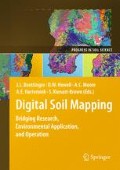Abstract
The digital representation of the Earth’s surface by terrain attributes is largely dependent on the scale at which they are computed. Typically the effects of scale on terrain attributes have only been investigated as a function of digital elevation model (DEM) grid size, rather than the neighborhood size over which they are computed. With high-resolution DEM now becoming more readily available, a multi-scale terrain analysis approach may be a more viable option to filter out the large amount short-range variation present within them, as opposed to coarsening the resolution of a DEM, and thereby more accurately represent soil-landscape processes. To evaluate this hypothesis, two examples are provided. The first study was designed to evaluate the systematic effects of varying both grid and neighborhood size on terrain attributes computed from LiDAR. In a second study, the objective was to examine how the correlations between soil and terrain attributes vary with neighborhood size, so as to provide an empirical measure of what neighborhood size may be most appropriate. Results suggest that the overall representation of the land surface by terrain attributes is specific to the land surface, but also that the terrain attributes vary independently in response to spatial extent over which they are computed. Results also indicate that finer grid sizes are more sensitive to the scale of terrain attribute calculation than larger grid sizes. For the soil properties examined in this study, slope curvatures produced the highest coefficients of correlation when calculated at neighborhood sizes between 117 and 189 m.
Access this chapter
Tax calculation will be finalised at checkout
Purchases are for personal use only
Preview
Unable to display preview. Download preview PDF.
References
Burrough, P.A., van Gaans, P.F.M., and MacMillan, R.A., 2000. High-resolution landform classification using fuzzy k-means. Fuzzy Sets and Systems 113:37–52.
Claessens, L., Heuvelink, G.B.M., Schoorl, J.M., and Veldkamp, A., 2005. DEM resolution effects on shallow landslide hazard and soil redistribution modelling. Earth Surface Processes and Landforms 30:461–477.
Chaplot, V., Darbouz, F., Bourennane, H., Leguedois, S., Silvera, N., and Phachomphon, K., 2006. Accuracy of interpolation techniques for the derivation of digital elevation models in relation to landform types and data density. Geomorphology 177:126–141.
Florinsky, I.V., 1998. Accuracy of local topographic variables derived from digital elevation models. International Journal of Geographic Information Science 12(1):47–61.
Florinsky, I.V., and Kuryankova, G.A., 2000. Determination of grid size for digital terrain modelling in landscape investigations – exemplified by soil moisture distribution at a micro-scale. International Journal of Geographical Information Science 14(8):815–832.
Gallant, J.C., and Hutchinson, M.F., 1997. Scale dependence in terrain analysis. Mathematics and Computers in Simulation 43:313–321.
McBratney, A.B., Mendonça Santos, M.L., and Minasny, B., 2003. On digital soil mapping. Geoderma 117:3–52.
McKenzie, N.J., and Ryan, P.J., 1999. Spatial prediction of soil properties using environmental correlation. Geoderma 89:67–94.
O’Connell, D.A., Ryan, P.J., McKenzie, N.J., and Ringrose-Voase, A.J., 2000. Quantitative site and soil descriptors to improve the utility of forest soil surveys. Forest Ecology and Management 138:107–122.
Park, S.J., McSweeney, K., and Lowery, B., 2001. Identification of the spatial distribution of soils using a process-based terrain characterization. Geoderma 103:249–272.
Schmidt, J., and Hewitt, A., 2004. Fuzzy land element classification from DTMs based on geometry and terrain position. Geoderma 121:243–256.
Schoeneberger, P.J., Wysocki, D.A., Benham, E.C., and Broderson, W.D. (eds.), 2002. Field Book for Describing and Sampling Soils, Version, 2.0. Natural Resources Conservation Service, National Soil Survey Center, Lincoln, NE.
Smith, M.P., Zhu, A.X., Burt, J.E., and Stiles, C., 2006. The effects of DEM resolution and neighborhood size on digital soil survey. Geoderma 137:58–69.
Wood, J., 1996. The geomorphological characterization of Digital Elevation Models. PhD Thesis Department of Geography, University of Lancaster, UK.
Zevenbergen, L.W., and Thorne, C.R., 1987. Quantitative analysis of land surface topography. Earth Surface Processes and Landforms 12(1):47–56.
Author information
Authors and Affiliations
Corresponding author
Editor information
Editors and Affiliations
Rights and permissions
Copyright information
© 2010 Springer Science+Business Media B.V.
About this chapter
Cite this chapter
Roecker, S., Thompson, J. (2010). Scale Effects on Terrain Attribute Calculation and Their Use as Environmental Covariates for Digital Soil Mapping. In: Boettinger, J.L., Howell, D.W., Moore, A.C., Hartemink, A.E., Kienast-Brown, S. (eds) Digital Soil Mapping. Progress in Soil Science, vol 2. Springer, Dordrecht. https://doi.org/10.1007/978-90-481-8863-5_5
Download citation
DOI: https://doi.org/10.1007/978-90-481-8863-5_5
Publisher Name: Springer, Dordrecht
Print ISBN: 978-90-481-8862-8
Online ISBN: 978-90-481-8863-5
eBook Packages: Earth and Environmental ScienceEarth and Environmental Science (R0)

